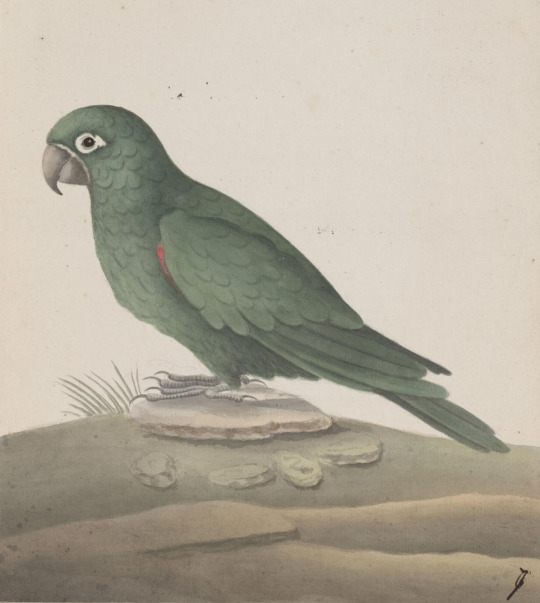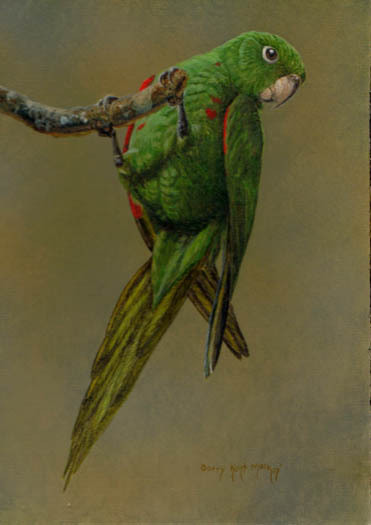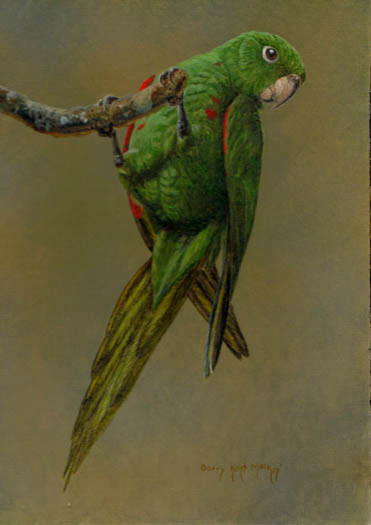#hispaniolan parakeet
Text

Hispaniolan parakeet (Psittacara chloropterus)
Part of a collection of watercolors by "M. Rabié" for St. Domingue Oiseaux. Dated 1766.
Internet Archive
90 notes
·
View notes
Photo

A new variant has been added!
Hispaniolan Parakeet (Psittacara chloropterus)
© Barry Kent MacKay
It hatches from agricultural, common, green, gregarious, large, long, other, overall, red, sleek, stout, and urban eggs.
squawkoverflow - the ultimate bird collecting game
🥚 hatch ❤️ collect 🤝 connect
0 notes
Text

Hispaniolan Parakeet. I still have this little life size study, one of my favourite parrot paintings (of mine, I mean…other artists have done better parrots).
art may be used for non-commercial purposes with attribution
prints and original art for sale on Fine Art America
support barry kent mackay on ko-fi
27 notes
·
View notes
Text
unusually poetic common names found browsing lists of extinct or critically endangered animals on wikipedia: insular cave rat, elusive skimmer, indefatigable galápagos mouse, confused moth, hispaniolan edible rat, cryptic treehunter, society parakeet, laughing owl, cave squeaker, beautiful armadillo, gloomy tube-nose bat
17 notes
·
View notes
Text
A new species of finch has been discovered on the Caribbean island of Hispaniola, a study in the journal Avian Research says.
The new species, dubbed the Hispaniolan verdant finch (Vireo crassirostris), was found to be genetically distinct from the other finch species on the island, the Hispaniolan pine warbler (Dendroica dominica).
The new species was first spotted in 2017 by an ornithologist in the Dominican Republic. After further study, scientists were able to confirm that the bird was a new species.
The Hispaniolan verdant finch is a small green bird with a yellow face, a black stripe along its forehead, and a white eye ring. It is about four inches in length and is found in subtropical and tropical moist lowland forests.
The new species is the first newly discovered finch in the Caribbean in over a century. It is believed to be the first species of bird to be discovered in the country since the discovery of the Hispaniolan parakeet in 1865.
The discovery of the Hispaniolan verdant finch is an important step in understanding the evolution of birds in the Caribbean island chain. It also highlights the importance of conservation efforts in the region, as the new species is already considered to be threatened by habitat loss and degradation.
0 notes
Photo

May 13, 2020 - Hispaniolan Parakeet, Hispaniolan Conure, or San Domingo Conure (Psittacara chloropterus)
Found in woodlands and sometimes agricultural or urban areas in the Dominican Republic and Haiti, these parrots have been introduced to Guadeloupe and Puerto Rico. They feed on fruits, seeds, nuts, buds, flowers, and grains, usually foraging in pairs or small groups, sometimes joining larger flocks. Nesting in tree cavities or arboreal termite nests, they lay clutches of two to four eggs. They are classified as Vulnerable by the IUCN as their population is declining in their small, fragmented range due to habitat loss and hunting.
#hispaniolan parakeet#parakeet#parrot#psittacara chloropterus#bird#birds#illustration#art#tropical#birblr art
65 notes
·
View notes
Photo

Birdie 🦜! • The Hispaniolan Trogon is the national bird of Haiti. It is a species of bird in the family Trogonidae. It is endemic to Hispaniola in the Caribbean. One of the only two trogon species found in the Caribbean whose natural habitats are subtropical and heavily degraded forests. It is threatened by habitat loss and currently is confined to a few remaining protected areas. • The Hispaniolan parakeet, also known as perico or periquito is a species of parrot in the family Psittacidae. It is endemic to the island of Hispaniola. Its natural habitats are subtropical or tropical dry forest, subtropical moist lowland forest, subtropical moist montane forest and arable land. . . . . . . . . . . . . . . . . . /* references- Flickr, Pinterest, wikipedia*/ #nature #wildlife #faune #protegerlaplanete #protegerlafauna #protectwildlife #haiti #haitinationalbird #goodworldn #theworld_network #beauty (at Haïti) https://www.instagram.com/p/CD0_tlMg9WY/?igshid=1u4yjs5n6qig8
#nature#wildlife#faune#protegerlaplanete#protegerlafauna#protectwildlife#haiti#haitinationalbird#goodworldn#theworld_network#beauty
0 notes
Video
youtube
From American Bird Conservancy Bird of the Week; December 29, 2017:
Golden-headed Quetzal
SCIENTIFIC NAME: Pharomachrus auriceps
POPULATION: Unknown, but considered fairly common
TREND: Stable
HABITAT: Humid mountain and cloud forests of South America
A handful of spectacular species, found only in the Americas, are known as “quetzals.” All are part of the trogon family — colorful, fruit-eating tropical birds that include the better-known Resplendent Quetzal and Haiti's national bird, Hispaniolan Trogon.
The name "quetzal" is from the Nahuatl (Aztec) quetzalli, meaning "large brilliant tail feather," and Golden-headed Quetzal fits the bill perfectly. This beautifully plumed species has a distinctive golden-bronze head, iridescent green body and wings, and long wing and tail coverts.
Beyond beauty, the Golden-headed Quetzal's shimmering green and gold plumage provides effective camouflage in its arboreal habitat. Combined with its habit of perching quietly, usually on a horizontal branch in the forest canopy, this big, flashy bird remains surprisingly inconspicuous.
Forest Gardener
Throughout much of its range from the northern Andes south to Bolivia, the distribution of Golden-headed Quetzal overlaps with that of the Crested Quetzal. It's possible to see or hear both species at the same site (including at the ABC-supported Buenaventura Reserve in Ecuador).

Like other fruit-eating birds, such as Bearded Bellbird, Banded Cotinga, and Hooded Berryeater, the Golden-headed Quetzal helps maintain the forests where it lives by spreading seeds through its droppings. It will also swallow larger fruits whole, then regurgitate the pits.

Female Golden-headed Quetzal by Ondrej Prosicky, Shutterstock
Creating the Perfect Cavity
Golden-headed Quetzals are usually solitary, but remain with one mate during the nesting season. The male attracts a female by establishing a territory and advertising it with a series of melancholy-sounding, hawk-like whistles; another call is a horse-like whinny.
Like Blue-throated Macaw, Thick-billed Parrot, and Golden-plumed Parakeet, the Golden-headed Quetzal nests in tree cavities, digging out decaying tree trunks or modifying existing hollow spots in old trees with their short, sturdy beaks. Because they require dead trees soft enough to excavate but still sturdy enough to support a nest, these quetzals may investigate multiple trees before finding the ideal nest site.
Although Golden-headed Quetzal is considered fairly common throughout its range, the species still faces threats from habitat loss, as do so many other birds. Several ABC-supported reserves provide habitat for the species, including Peru's Abra Patricia — also home to the rare Long-whiskered Owlet and Ochre-fronted Antpitta — and Ecuador's Tapichalaca, which shelters Jocotoco Antpitta.
2 notes
·
View notes
Text
March 10 Green Energy News
Headline News:
“Haiti: The University Planning A Green Revolution” • North Haiti Christian University is a place where students learn about sustainable agriculture. In a country where deforestation earns as many superlatives as poverty, it has had a generations-long ban on tree felling on its 19-acre campus. This produced a haven for rare, endemic birds. [BBC]
Hispaniolan parakeet (Michael McGovern)
“The Bogus Number At The Center Of The GOP’s Green New Deal Attacks” • Republicans claim the Green New Deal would cost $93 trillion, a number that would dwarf the economic output of every nation on Earth. The number supposedly originated with a report by a conservative think tank, American Action Forum. But it is not there. [Politico]
“Study Finds Dumping Coal Would Bring US In Line With Paris Climate Accord Goals” • A study by the physics, economics, and system science departments at Portland State University says that the US could meet the Paris Accord commitments it made in 2015 simply by eliminating coal as a source of electrical energy by 2024. [CleanTechnica]
“Attis Industries To Expand NY Ethanol Production, Add More Renewables” • Attis Industries announced plans to build a green tech campus near its ethanol plant in Fulton, New York. Attis is looking to buy land to set up a bio-refinery and a biodiesel plant, which could use as feedstock the corn extract produced from the ethanol facility. [Renewables Now]
Ethanol plant (Jim Parkin | Shutterstock.com)
“Lawmakers Consider Proposal To Support Green New Deal Study” • Rhode Island lawmakers are considering resolutions to release the findings of a study on the state impact of the national Green New Deal. Research council project manager Michael Roles says they hope to have a report ready for legislators by May 15. [Boston Herald]
For more news, please visit geoharvey – Daily News about Energy and Climate Change.
March 10 Green Energy News posted first on Green Energy Times
0 notes
Photo

A new variant has been added!
Hispaniolan Parakeet (Psittacara chloropterus)
© Barry Kent MacKay
It hatches from agricultural, common, green, gregarious, large, long, other, overall, red, sleek, stout, and urban eggs.
squawkoverflow - the ultimate bird collecting game
🥚 hatch ❤️ collect 🤝 connect
1 note
·
View note
Text

Hispaniolan Parakeet. Another detail from a larger painting.
art may be used for non-commercial purposes with attribution
prints and original art for sale on Fine Art America
support barry kent mackay on ko-fi
1 note
·
View note